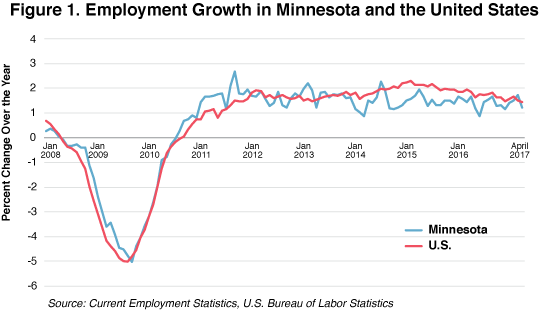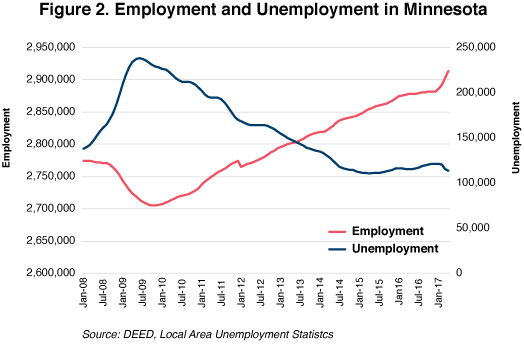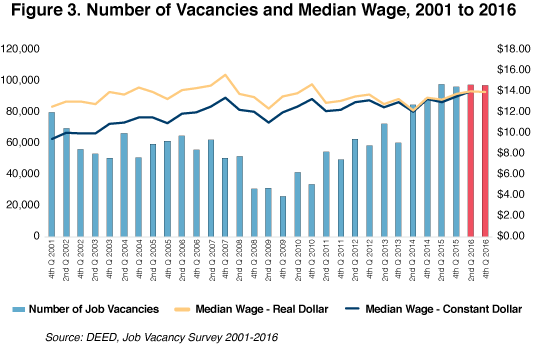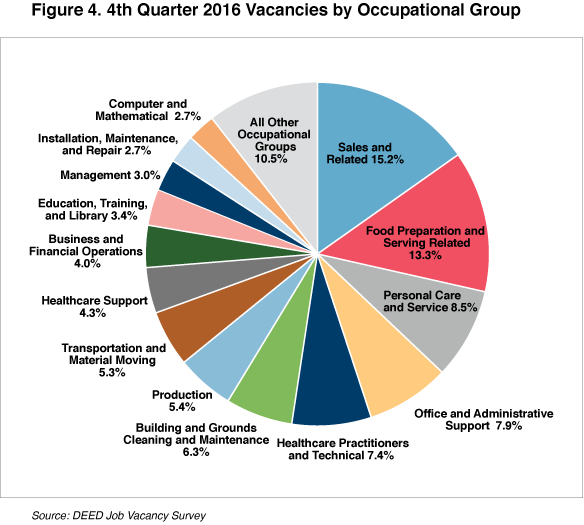

by Matthew Bombyk, Nicholas Dobbins, Steve Hine, Mohamed Mourssi and Dave Senf
June 2017
With the recovery now eight years old, the Minnesota economy appears to be at or near full employment.
The stories in this issue describe an economy that is still recovering from the ravages of the recession that officially ended eight years ago in June. Indeed, as of March, this expansion was the third-longest in U.S. history, at 93 months and counting.
As impressive as that is, though, the depth and severity of the recession means that by some measures we can only now claim that our labor markets have recovered. At the same time, from a macroeconomic perspective, the state appears to have reached “full employment.”
It is important to clarify what is meant by this term, especially when many of us are unemployed or know someone who is. How can we claim to be at “full employment” when clearly some Minnesotans are unemployed? The explanation for this disconnect is that a dynamic economy, even in the best of times, will experience declines in some sectors or regions even as growth persists in others.
For example, while jobs are being added in industries like health care and construction, employment in manufacturing and information has yet to recover the losses experienced eight years ago. Automation in many manufacturing plants, and a shift in telecommunications from wired technology to wireless have contributed to employment decline in these areas, even as these technological advances provide improvements to our overall living standards.
Currently, unemployment largely represents a desirable reallocation of our workforce from areas that have a shrinking need for workers to areas that have a growing need. This reallocation doesn’t happen instantaneously. Moving from one industry to another might require time for workers to seek the right opportunity or accumulate the right skill set through training or education. Similarly, moving from a region that has experienced a plant shutdown to another region with suitable opportunities for the affected workers requires time for relocation.
Unemployment during full employment also arises as new entrants search for their first jobs. Job searches take time. Think of that newly minted college graduate now embarking on his or her first job. Research strongly supports the crucial influence that a first job can have on a person’s lifelong earnings trajectory, so taking time at the outset can result in a better allocation of labor resources further down the road.
Unemployment that arises when workers require time to find jobs is called “frictional” unemployment because it arises through the inability to instantly move between jobs. It is a manifestation of an efficient reallocation of our workforce in a dynamic and ever-changing economy. That is not to say that a laid-off production worker or a miner who needs to re-skill or relocate does not experience hardship. While there are numerous programs administered by DEED and other entities to mitigate these hardships, this reallocation is a necessary and continual process in a dynamic economy.
Getting back to the current state of our economy, there are strong indications that 2016 moved us into or near full employment. For example, during the fourth quarter of 2016, our Job Vacancy Survey revealed that there were 1.1 unemployed Minnesotans for every job vacancy in the state, a rate that has been essentially stable for the past two years. In other words, there are as many openings as there are people vying to fill them, although they may not necessarily be in the same place or have the right skill set. This is evidence that our current unemployment is largely frictional in nature, as opposed to the significant “cyclical” unemployment we faced eight years ago when there were 8.2 unemployed people for every vacancy.
Another persuasive sign of full employment has been recent increases in the average wage rate across many sectors of our economy. As of April, average wages of private sector workers are up 7.5 percent over a year ago, with many industries contributing to this strong wage growth, including professional and business services (7.3 percent), manufacturing (6.8 percent), financial activities (7.4 percent), education and health care (6.8 percent), and leisure and hospitality (8.6 percent).
Considering that a year ago private sector annual wage growth was 3.5 percent and a year before that it was 0.5 percent, we are certainly seeing tight labor markets yield long-awaited wage gains.
A final statistic that supports the claim that full employment has been realized is the unemployment rate itself. Our official unemployment rate fell from a recessionary peak of 8.1 percent in June 2009 to 4 percent in July 2014, remaining at or slightly below that level ever since, most recently standing at 3.8 percent in April 2017. Correspondingly, the number of unemployed Minnesotans has consistently been in the 110,000 to 120,000 range throughout the last four years. The persistence of this number during a period when we have added about 125,000 jobs is consistent with this being a normal level of frictional unemployment.
Before concluding that all those unemployed Minnesotans can be characterized as “frictional,” it is important to note that Minnesota continues to experience a disparity in unemployment across racial lines. As of April 2017, the average unemployment rate over the previous 12 months for all black Minnesotans stood at 8.1 percent. That rate is well down from its recessionary peak of 23.3 percent but still much higher than the comparable rate of 3.1 percent for white Minnesotans.
Whether or not black unemployment is frictional in nature, it is the case that hiring 7,600 currently unemployed black Minnesotans would lower their unemployment rate to 3.1 percent. In other words, even if the racial disparities are indeed driven by factors unrelated to frictions in worker reallocations, their share of overall unemployment is fairly small.
This is important to note as we move into a prolonged period of much slower labor force growth. Racial disparities are a significant socio-economic problem that needs to be addressed. But as important as they are to correct, doing so will not substantially offset the worker shortages that will exist in the years ahead.
Job growth, therefore, will be constrained by the slower growth in available workers, which will in turn depend largely on whether foreign immigration continues to be a strong source of workers and whether older people can be enticed to work beyond traditional retirement age.
While the impact of these factors is not clear, one thing is certain: An economy at full employment will prolong recent wage gains and further reduce our persistent racial disparities through 2017 and hopefully beyond.
Minnesota employment grew 1.4 percent in 2016, the same rate as 2014 and slightly less than the growth rate of 1.5 percent in 2015. This rate of expansion seems to be the new normal – at least for the time being – as both Minnesota and the United States have generally averaged between 1 and 2 percent annual employment growth in recent years, a decrease from more rapid growth right after the Great Recession.
While a leveling off is common, current rates are still well below recent historical averages. For comparison, average annual growth rates over 2 percent and sometimes 3 percent were common in the 1980s and ‘90s. This lower rate of job growth mirrors the stagnation that’s occurring across the broader economy.
For April, the most recent month for which we have data, preliminary estimates peg the over-the-year growth rate at 1.2 percent, although there is a significant amount of fluctuation in single-month estimates (March had 1.7 percent annual growth). The state added 32,920 jobs in calendar year 2016 and 34,715 jobs in the 12 months that began in April 2016.
In the months immediately before and after the recession, Minnesota job growth performed well compared with the national average. While the job markets bottomed out at similar levels, job losses came slightly later here than nationally and our rebound was stronger in the initial recovery from 2010 to 2011. Minnesota employment returned to its pre-recession peak by August 2013, while it took the U.S. until May 2014 to reach the same benchmark (see Figure 1).

By late 2013 and early 2014, however, Minnesota job growth began to level off. At the same time, U.S. job growth sped up. As a result, our growth rate fell well behind the national pace, with annual growth rates at 1.4 and 1.5 percent in 2014 and 2015, respectively, compared with national rates of 1.9 and 2.1 percent. Over the past 1-1/2 years, that gap began to close: Minnesota’s 2016 average growth rate of 1.4 percent compares more favorably to the national average of 1.7 percent. By March 2017, over-the-year growth in Minnesota (1.7 percent) outperformed the national rate of 1.5 percent for the first time since mid-2014.
Employment growth has not occurred uniformly across industries. In the 12 months leading up to April 2017, Minnesota added 34,715 jobs (see Table 1). More than half of that gain (18,929 jobs) was in the educational and health services supersector, but it accounted for just 18.6 percent of all jobs in the state in April. The health care portion of that supersector is by far the bigger of the two, accounting for 16 percent of all Minnesota jobs. The 3.6 percent over-the-year (OTY) growth in the supersector far exceeded the U.S. rate of 2.2 percent.
| Employment in Minnesota and the United States, April 2017 | ||||
|---|---|---|---|---|
| Industry | Minnesota Employment | Minnesota OTY Change | U.S. Employment | U.S. OTY Change |
| Total Nonfarm | 34,715 | 1.2 | 145,979,000 | 1.4 |
| Total Private | 32,030 | 1.3 | 123,256,000 | 1.6 |
| Mining and Logging | 787 | 13.7 | 693,000 | 3.6 |
| Construction | 3,021 | 2.7 | 6,769,000 | 2.4 |
| Manufacturing | 391 | 0.1 | 12,333,000 | 0.3 |
| Trade, Transportation and Utilities | 1,899 | 0.4 | 27,142,000 | 0.7 |
| Information | 1,107 | 2.2 | 2,729,000 | -2.0 |
| Financial Activities | 2,263 | 1.3 | 8,383,000 | 2.1 |
| Professional and Business Services | 2,858 | 0.8 | 20,556,000 | 2.9 |
| Educational and Health Services | 18,929 | 3.6 | 23,176,000 | 2.2 |
| Leisure and Hospitality | -2,437 | -0.9 | 15,745,000 | 1.8 |
| Other Services | 3,212 | 2.8 | 5,730,000 | 1.0 |
| Government | 2,685 | 0.6 | 22,723,000 | 0.6 |
| Source: Current Employment Statistics, U.S. Bureau of Labor Statistics | ||||
Minnesota also greatly outperformed the country in the information supersector in April. That follows many years in which Minnesota shed jobs while the U.S. added jobs in information. Minnesota's strong over-the-year growth does not make up for previous weakness.
Minnesota's employment growth has significantly underperformed the national rate in some industries. As of April 2017, professional and business services accounted for over 14 percent of nonfarm jobs nationally and 12.8 percent in Minnesota. Nationally, over the last three years the supersector's OTY growth averaged 3 percent in 2014 and 2015, 2.6 in 2016, and 2.9 percent in April 2017. Minnesota's OTY growth in professional and business services, on the other hand, averaged only 1.6 percent in 2014 and 2015, 1.5 percent in 2016, and 0.8 percent in April.
Employment services, a component sector within professional and business services that includes temporary help employees, is often seen as a leading labor market indicator. It has been shedding jobs in Minnesota since 2015 and was down 2.5 percent OTY in April. In contrast, the industry grew steadily nationally, up 3.2 percent OTY in April, though average growth has decreased nationally every year since 2010. It is possible that the decline in temp help employment in Minnesota is a result of the tightening labor market.
Leisure and hospitality, the only supersector to lose jobs in April, was off by 0.9 percent, compared with the country's 1.8 percent increase. Leisure and hospitality employment has been declining in Minnesota since late 2016, while nationwide it hasn't seen a month of OTY job loss since 2010, although growth rates have been slowing in recent months.
Overall unemployment has remained stable for the past three years, and this is true from the most narrow to the broadest definition of unemployment. 2015 opened with a seasonally adjusted January U-3 unemployment rate (the official unemployment rate, which counts only those who are actively looking for work) of 3.8 percent. The rate ended in December at 3.9 percent, with minimal movement in the interim.
2016 likewise started at 3.9 percent and ended at 4 percent. In the most recent two months for which we have estimates, March and April 2017, rates again ticked down, to 3.8 percent. The state unemployment rate seems to have found its level, staying firmly between 3.7 and 4 percent since June 2014. Meanwhile, the national unemployment rate continues to close the gap. It has been steadily declining since 2010, sitting at 4.4 percent as of April preliminary estimates, after starting 2016 at 4.9 percent.
The 2016 average annual labor force in Minnesota was 2,996,712, an increase of 25,771 from 2015 estimates. The labor force participation rate was unchanged at 69.5 percent, and the employment-to-population ratio ticked down from 66.9 percent to 66.8 percent. While employment growth was minimal in 2016, and the total number of unemployed actually inched up slightly over the year, early 2017 has seen more significant improvements in both measures (see Figure 2).

Minnesota's official unemployment rate tells us a lot about the share of people in the labor force who have untapped potential. But it doesn't tell the whole story. We can learn more by looking beyond the traditional unemployment rate at alternative definitions of the unemployed and by examining unemployment rates by age, gender and race (see Table 2).1
| Measures of Unemployment | |||
|---|---|---|---|
| Measures of Unemployment Type | Unemployment Rate (%)April 2016 | Unemployment Rate (%)April 2017 | Percent Change |
| U3 (Official) | 3.7 | 3.9 | 0.2 |
| U6 | 8.0 | 7.7 | -0.3 |
| Long-term (over 6 months)
share of unemployed |
14.8 | 11.2 | -3.6 |
| Age 16-19 | 7.8 | 11.4 | 3.6 |
| Female | 3.0 | 3.3 | 0.3 |
| Male | 4.3 | 4.4 | 0.1 |
| Black | 12.0 | 8.1 | -3.9 |
| White | 2.9 | 3.1 | 0.2 |
| Hispanic | 5.0 | 5.4 | 0.4 |
| Source: DEED, Labor Market Information Office | |||
When we break out unemployment rates by race, we find that some groups face greater challenges than others. White and Hispanic unemployment increased slightly over the year, while black unemployment fell. White unemployment rose to 3.1 percent in April 2017 from 2.9 percent a year ago, while Hispanic unemployment rose from 5 percent to 5.4 percent. Black unemployment fell substantially from 12 percent to 8.1 percent, though it still remains at more than double the white rate. Although it appears that the fall in black unemployment is real and sustained, it is difficult to gauge the true magnitude because of the large degree of sampling error for this group arising from small sample sizes.
Overall, the broad U-6 employment rate (counting anyone who looked for work in the past year, as well as anyone working part time but wanting to work full time) fell from 8 percent to 7.7 percent. Taken together, these trends imply a substantial reduction in the number of involuntary part-time workers, which fell nearly 10 percent from 102,000 to 92,000.
The number and share of long-term unemployed (six months or more) continued their downward trends since peaking in 2011, and both are now the lowest they have been since 2002. The number fell to 12,900 in April 2017, down from 16,600 in April 2016, while the share of long-term unemployed among all unemployed fell from 14.8 percent to 11.2 percent. The continued decline in long-term unemployment shows that the labor market continues to tighten even as the overall unemployment rate appears to have bottomed out.
Teenage unemployment increased sharply in the past year, starting in mid-2016. The teen unemployment rate was 7.8 percent in April 2016, and rose to 11.4 by April 2017. This rise coincided with the minimum wage increase which took effect in August of 2016. This raised minimum wages to $7.75/hr for those under age 18, and $9.50/hr for everyone else, and is notable because minimum wage rules tend to apply disproportionately to teen workers. However, the teenage labor force participation rate also increased substantially during this period, from 49.9 to 52.6 percent. Increases in labor force participation also tend to increase the unemployment rate. The number of teenagers in the labor force increased by nearly 14,000 from April 2016 to April 2017. While nearly 7,000 of these entrants became unemployed, an even larger number, just over 7,000, became employed. Because of this increase in labor force participation, it is difficult to say what effect, if any, the minimum wage increase had on teenage unemployment.
The unemployment rate for all men has stayed in a narrow band between 4.1 and 4.5 percent since November 2014, most recently registering at 4.4 percent in April 2017. The unemployment rate for all women may have hit the bottom of a long downward trend in summer of 2016, when it reached a low of 2.7 percent, from a summer 2011 high of 6.3 percent. After a five-month rise following summer, the unemployment rate among women registered at 3.3 percent in April.
In 2016, job vacancies reached their highest level since DEED's Job Vacancy Survey (JVS) was launched 16 years ago, indicating a healthy labor market (see Figure 3). DEED reported about 98,000 job openings in the second quarter of 2016, similar to the number of jobs reported in second quarter 2015. In fourth quarter 2016, 97,400 vacancies were reported, up 1.3 percent from a year earlier, and representing the most job openings in any fourth quarter since the JVS started in the state. The job vacancy rate remained steady in 2016 at 3.6 (number of vacancies per 100 jobs). The number of unemployed per vacancy has remained steady over the last two years, ranging from 1 to 1.2 statewide. These are the lowest consecutive readings on record.
Figure 3 also shows year-over-year wage growth, as well as the movement of wage offers in real dollars (using the consumer price index for all urban consumers). Real wages take inflation into account, so any increase in real wage offers indicates they are rising faster than inflation.

Trends in real wage offers over the last 16 years occurred in three phases. The first phase covers the period from 2001 to 2007, when wage offers grew in real dollars. The second phase covered 2008 to 2011, the Great Recession, when wage offers lost ground in real dollars. The last phase started in 2012 and reflects a leveling off in real wage offers with little growth.
In fact, growth in wage offers since 2012 has been, in part, driven by small increases in the two largest occupations: sales and related, and food preparation and serving. Median wage offers in food prep and serving increased from $7.58 to $10.94 between fourth quarter 2012 and fourth quarter 2016. Over the same period, median wage offers in retail trade increased from $9.71 to $11.43. These increases were likely driven in part by the step increases in Minnesota's minimum wage, which rose from $7.25 at the beginning of 2014 to $9.50 by August 2016, pushing up wages in the lowest-wage occupations.
Although small increases in median wage offers indicate recovery for the Minnesota economy and labor market, real wage offers have not reached their pre-recession levels.
More than half (52 percent) of all reported vacancies during fourth quarter 2016 were concentrated in five occupational groups: sales and related occupations (15.2 percent of all vacancies), food preparation and serving (13.3 percent), personal care and service (8.5 percent), office and administrative support (7.9 percent) and health care practitioners and technical occupations (7.4 percent) (see Figure 4).

About 55 percent of jobs in these five groups were part time — defined for the survey as fewer than 35 hours a week. Most were not seasonal or temporary. In general, part-time jobs are less likely to offer health insurance benefits. In fact, only 48 percent of the vacancies in these five occupational groups offered health insurance benefits.
Minnesota's job growth is off to another solid start in 2017, averaging 1.5 percent higher than a year ago through the first three months. That is above the 1.2 percent increase expected for all of 2017. Slower labor force growth will likely slow job growth in 2017.
The unemployment rate – after increasing in 2016 – dropped to 3.8 percent in March, the lowest rate in over a year. The jobless rate is likely to continue to edge down, with employment growth remaining solid through the rest of the year. The 1.2 percent forecasted annual average employment growth for 2017 will be the lowest since jobs started to rebound in 2011.
Annual job growth averaged 1.6 percent between 2011 and 2016, including the 1.4 percent increase recorded last year. That is the best six-year average since 1996 to 2001, when employment expanded on average by 2 percent annually. Labor force growth climbed 1.5 percent annually during the 1996 to 2011 period, but has expanded by only 0.9 percent since 2011. Slower annual labor force growth is expected in 2017, which will curb job growth below last year's pace. Overall, the Minnesota economy is forecast to generate 35,000 wage and salary jobs in 2017, down modestly from the 40,000 added last year.
Labor market indicators were positive during the first few months in 2017, suggesting that job growth will remain on track this year. Job vacancies remain at post-recession highs, as employers search for new hires from a shrinking pool of unemployed. Manufacturing hours are slowly climbing after having slipped over the last two years. Homebuilding permits have reached levels not seen since 2006. Initial claims for unemployment remain at record-low levels as employers hang onto their workforces in a tight job market. Those indicators point toward another year of steady employment expansion in the state.
The 1.2 percent job growth expected in 2017 will be widespread, with most of Minnesota's industries adding workers. Payroll numbers are expected to decline in only three industries – natural resources and mining, state government higher education, and utilities. Ambulatory health care services, social assistance, and food services and drinking places are anticipated to add the most jobs. Manufacturing and construction employment, having partially rebounded from steep cutbacks during the recession, are expected to experience minimal hiring for the second year in a row.
The pace of hiring is also expected to slow compared with the previous six years in the retail and the professional, scientific and technical industries. Industries expected to add employment faster this year than between 2001 and 2016 include accommodations, information and other private services. Table 3 compares the average annual change in employment across industries between 2011 and 2016 to the forecasted change in 2017.
| Minnesota Industry Forecast to 2018 | |||||
|---|---|---|---|---|---|
| Industries | 2011 | 2017 | 2018 | Average Percent Change 2011 - 2017 | Percent Change 2017 - 2018 |
| Total All Industries | 2,612,045 | 2,869,298 | 2,904,481 | 1.6 | 1.2 |
| Goods Producing | 372,576 | 422,503 | 425,284 | 2.1 | 0.7 |
| Natural Resources and Mining | 6,085 | 6,334 | 6,274 | 0.7 | -0.9 |
| Construction | 73,805 | 102,386 | 104,538 | 5.6 | 2.1 |
| Manufacturing | 292,685 | 313,783 | 314,472 | 1.2 | 0.2 |
| Service Providing | 2,239,470 | 2,446,795 | 2,479,197 | 1.5 | 1.3 |
| Utilities | 12,752 | 12,276 | 12,201 | -0.6 | -0.6 |
| Wholesale Trade | 122,410 | 130,056 | 130,574 | 1.0 | 0.4 |
| Retail Trade | 270,003 | 296,547 | 299,155 | 1.6 | 0.9 |
| Transportation and Warehousing | 77,464 | 88,737 | 90,055 | 2.3 | 1.5 |
| Information | 53,361 | 50,608 | 50,670 | -0.9 | 0.1 |
| Finance and Insurance | 129,635 | 143,127 | 146,007 | 1.7 | 2.0 |
| Real Estate and Rental and Leasing | 32,417 | 33,285 | 33,471 | 0.4 | 0.6 |
| Professional, Scientific, and Technical Services | 132,088 | 157,353 | 160,185 | 3.0 | 1.8 |
| Management of Companies and Enterprises | 71,847 | 78,656 | 79,778 | 1.5 | 1.4 |
| Administrative and Support and Waste Management and Remediation Services | 119,218 | 128,224 | 128,603 | 1.2 | 0.3 |
| Educational Services | 66,209 | 72,128 | 73,243 | 1.4 | 1.5 |
| Ambulatory Health Care Services | 126,325 | 152,488 | 157,287 | 3.2 | 3.1 |
| Hospitals | 98,716 | 107,672 | 109,176 | 1.5 | 1.4 |
| Nursing and Residential Care Facilities | 100,610 | 108,334 | 110,101 | 1.2 | 1.6 |
| Social Assistance | 73,057 | 93,458 | 97,665 | 4.2 | 4.5 |
| Arts, Entertainment, and Recreation | 32,385 | 36,366 | 37,217 | 2.0 | 2.3 |
| Accommodation, including Hotels and Motels | 23,630 | 23,021 | 23,293 | -0.4 | 1.2 |
| Food Services and Drinking Places | 165,649 | 188,458 | 191,560 | 2.2 | 1.6 |
| Other Services (except Government) | 113,091 | 117,122 | 118,537 | 0.6 | 1.2 |
| Government | 418,604 | 428,879 | 430,419 | 0.4 | 0.4 |
| Federal Government | 32,529 | 32,039 | 32,084 | -0.3 | 0.1 |
| State Government, Excluding Education | 37,155 | 38,885 | 39,117 | 0.8 | 0.6 |
| State Government Higher Education | 64,953 | 61,990 | 61,422 | -0.8 | -0.9 |
| Local Government, Excluding Education | 141,356 | 143,654 | 144,577 | 0.3 | 0.6 |
| Local Government Education | 142,610 | 152,311 | 153,219 | 1.1 | 0.6 |
|
Source: Minnesota Department of Employment and Economic Development All forecast periods are for the first quarter and are Current Employment Statistic jobs (non-farm wage and salary employment). |
|||||
Table 4 compares the same percent changes but from the occupational side of employment. Production and the farming, forestry and fishing occupations are the only major groups anticipated to lose employment in 2017. Job cutbacks will be minimal in these two fields. The groups expected to add the most jobs in 2017 are personal care and service, office and administrative support, and food preparation and serving related.
| Minnesota Occupational Forecast to 2018 | |||||
|---|---|---|---|---|---|
| Occupations | 2011 | 2017 | 2018 | Average Percent Change 2011 - 2017 | Percent Change 2017 - 2018 |
| Total | 2,612,045 | 2,869,298 | 2,904,481 | 1.6 | 1.2 |
| Management | 135,129 | 172,317 | 174,505 | 4.1 | 1.3 |
| Business and Financial Operations | 152,945 | 171,329 | 173,849 | 1.9 | 1.5 |
| Computer and Mathematical | 83,809 | 94,096 | 95,433 | 1.9 | 1.4 |
| Architecture and Engineering | 45,603 | 53,207 | 53,506 | 2.6 | 0.6 |
| Life, Physical, and Social Science | 29,155 | 25,350 | 25,624 | -2.3 | 1.1 |
| Community and Social Service | 69,819 | 57,249 | 58,341 | -3.3 | 1.9 |
| Legal | 17,555 | 19,006 | 19,184 | 1.3 | 0.9 |
| Education, Training, and Library | 197,117 | 217,087 | 218,526 | 1.6 | 0.7 |
| Arts, Design, Entertainment, Sports, and Media | 36,936 | 36,416 | 36,713 | -0.2 | 0.8 |
| Healthcare Practitioners and Technical | 156,686 | 174,882 | 178,273 | 1.8 | 1.9 |
| Healthcare Support | 98,364 | 92,995 | 94,869 | -0.9 | 2.0 |
| Protective Service | 45,746 | 50,023 | 50,699 | 1.5 | 1.4 |
| Food Preparation and Serving Related | 205,541 | 230,543 | 234,104 | 1.9 | 1.5 |
| Building and Grounds Cleaning and Maintenance | 77,289 | 71,856 | 72,980 | -1.2 | 1.6 |
| Personal Care and Service | 91,132 | 139,880 | 144,057 | 7.4 | 3.0 |
| Sales and Related | 250,774 | 275,750 | 278,363 | 1.6 | 0.9 |
| Office and Administrative Support | 410,031 | 411,469 | 415,199 | 0.1 | 0.9 |
| Farming, Fishing, and Forestry | 4,186 | 2,707 | 2,701 | -7.0 | -0.2 |
| Construction and Extraction | 66,791 | 89,558 | 91,234 | 5.0 | 1.9 |
| Installation, Maintenance, and Repair | 85,083 | 92,719 | 93,855 | 1.4 | 1.2 |
| Production | 200,686 | 215,534 | 215,339 | 1.2 | -0.1 |
| Transportation and Material Moving | 151,668 | 175,325 | 177,127 | 2.4 | 1.0 |
|
Source: Minnesota Department of Employment and Economic Development All forecast periods are for the first quarter and are Current Employment Statistic jobs (non-farm wage and salary employment). |
|||||
Jobs in community and social service; life, physical and social science; and health care support occupations are anticipated to increase faster in 2017 than in the previous six years. Job growth in management, construction and extraction, and personal care and service are forecast to slip below the pace set between 2011 and 2016.
Expected job growth this year represents only 1.2 percent of the 2.9 million jobs that will exist by the end of 2017 in Minnesota. Openings from employment growth represent a small percentage of all job openings that will occur this year as workers retire or move on to other occupations. Construction companies and manufacturing firms will have plenty of openings in 2017, even though their workforce numbers will be up only slightly from 2016.
1It should be noted that the rates presented in this section are averages over the previous 12 months and thus may differ slightly from other figures presented in this article. They are also based on relatively small sample sizes and are more prone to measurement errors. This is especially true for the rates broken out by race and for teenagers.